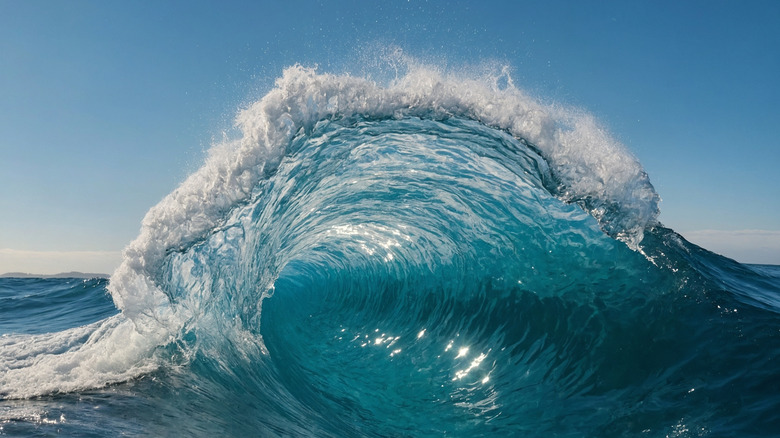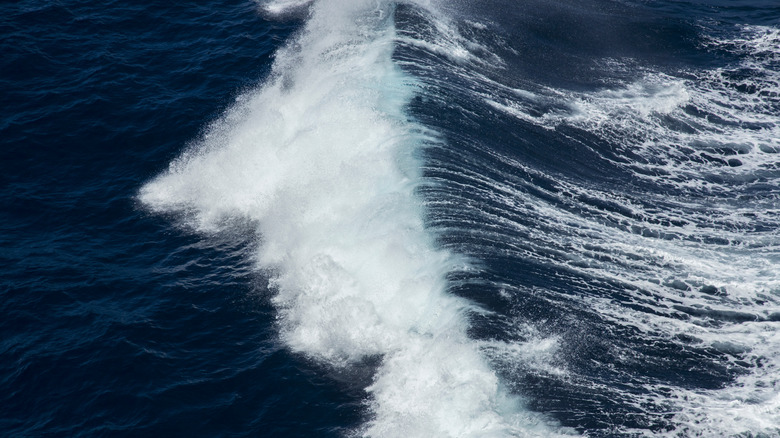Rogue Waves Might Not Be As Mysterious As We Thought, New Study Shows
The ocean is an intriguing and mysterious place. For every new species of sea creature we find, there are an untold number of others waiting to be discovered. But it isn't just sea life that has kept scientists enthralled. Unexplained phenomena like rogue waves have also kept their eyes on the open seas, with questions rising like the peak of a wave threatening to break. Now, it seems scientists have finally found the answer.
Despite how mythological they might sound — massive waves that can reach up to 65 feet (20 meters) or higher in the middle of the open ocean — rogue waves are very real, and scientists have been trying to figure out how they form for years. There have been several plausible-sounding theories, but when comparing lab experiments with the actual records of the open ocean, researchers say they don't always line up. That's why Francesco Fedele, an associate professor of civil and environmental engineering at the Georgia Institute of Technology, wanted to figure out exactly where they came from.
Having a better understanding of how rogue waves form can help us understand where they might appear. This, in turn, could help ships navigate difficult areas more easily. Despite how mysterious these waves appear on the surface, Fedele shared in a post on The Conversation that looking deeper reveals that rogue waves aren't "freak occurrences." Instead, they form under the very natural laws that govern our planet, and they're actually quite simple.
Theories behind rogue waves
Waves appearing in the open ocean isn't an unexpected phenomenon. Wind blowing across the surface of the sea tends to cause ripples — much in the same way wind blowing across the surface of the pool in your backyard might. However, to figure out why some waves go rogue and rise higher than the surrounding waves, the researchers needed to look deeper.
They started to look back at theories for why rogue waves form. Perhaps one of the most notable theories surrounding rogue waves and why they exist can be attributed to modulational instability. This ultimately requires what Fedele describes as "complex mathematical models" to properly describe. However, Fedele's team wasn't convinced this was the answer, as data gathered from the open ocean doesn't properly correlate with data captured within a controlled experiment in the lab, where the surface area is much narrower.
"To understand the difference, imagine a crowd of spectators leaving a stadium after a football game," Fedele explained. "If the exit is a long, narrow hallway with tall walls, people are forced to move in a single direction. Those at the back push forward, and some may even climb over others, piling up between the confining walls. This catastrophic pileup would resemble a rogue wave, caused by their confinement." He continued, "In contrast, if the stadium's exit opens onto a wide field, spectators can disperse freely in all directions. They don't push on each other, and they avoid pileups."
Constructive interference is the key
Fedele's team of international researchers combed through 18 years of high-frequency measurements taken from the North Sea. Readings were taken by the Ekofisk oil platform every half-hour, providing nearly 27,500 records for the team to work through. These contained detailed observations about how elevated the sea surface compared to the average in the area and painted a very different picture than lab results. Instead of modulational instability being the key, Fedele's team found that constructive interference might be the reasoning behind why these waves appear so quickly and grow so large before eventually dying off.
"Constructive interference happens when two or more waves line up and combine into one big wave," Fedele explained. "This effect is amplified by the natural asymmetry of sea waves – their crests are typically sharper and steeper than their flatter troughs. Rogue waves form when lots of smaller waves line up and their steeper crests begin to stack, building up into a single, massive wave that briefly rises far above its surroundings."
Thankfully, Fedele says that natural processes can limit how large a rogue wave can grow. While these new findings bring a bit more understanding to rogue waves as a whole, the ocean remains a mysterious place, complete with strange creatures like the humpback anglerfish, which some have referred to as a black seadevil fish due to its terrifying appearance.


